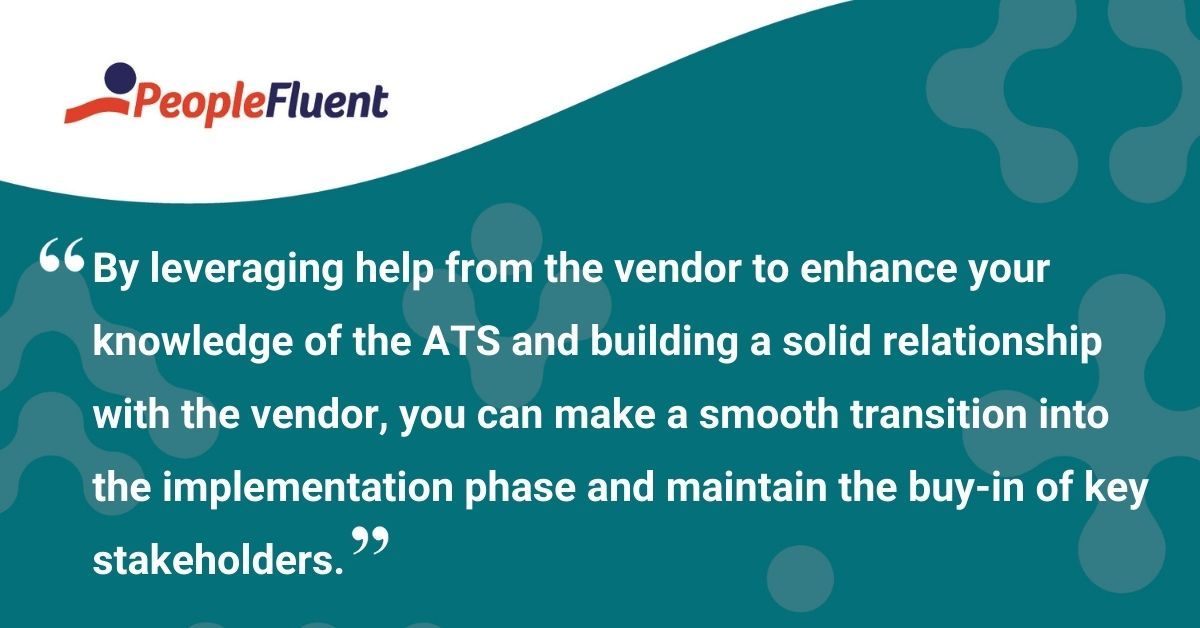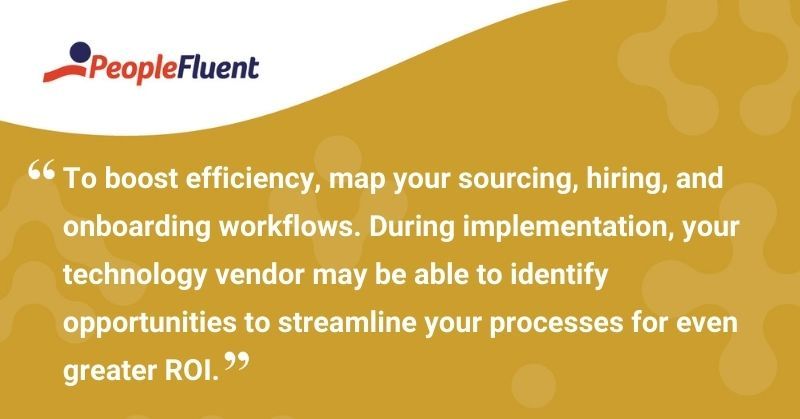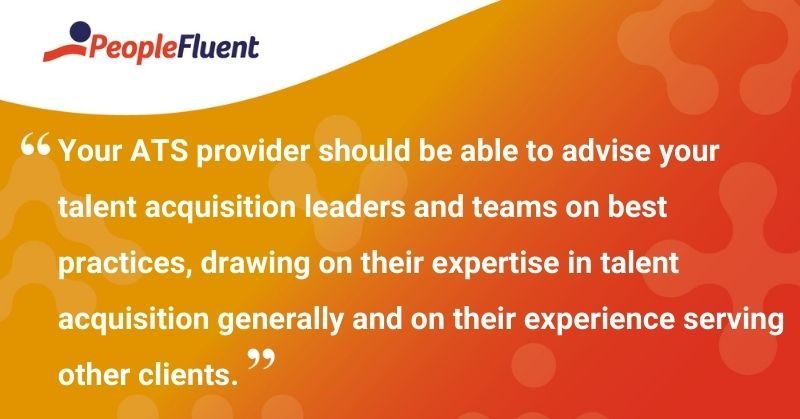Published: Apr 12, 2021Time to read: 6mins Category: Insights
How to Implement an ATS: 13 Things to Accelerate ROI
Your talent acquisition team has determined must-need features of an applicant tracking system, written a request for proposals, and assessed recruiting software demos. Now it's time to onboard the solution you chose to accelerate ROI. Read this article to discover 13 ways to accelerate the ROI of your new ATS.
A lot of work goes into selecting the right applicant tracking system (ATS) for your organization. Especially at the enterprise scale. You assembled a team of stakeholders—recruiters, hiring managers, talent acquisition leaders, HRIS admins, procurement, finance, and others. Together, you documented your recruiting and hiring process to determine which talent acquisition system would work your way.
You researched all the latest features and functions of a modern ATS and determined which provider would help your team work efficiently and attract the skilled and savvy job seeker. You wrote a request for proposals (RFP) and reviewed vendor responses. And you sat through demos and asked all the right questions.
Now you’re done, right? Wrong! Don’t dismiss your selection team just yet.
STILL IN SELECTION MODE? | 'How to Choose the Right Applicant Tracking System (ATS) for Your Organization '
Final Step in Selecting an ATS: Preparing for Implementation
Implementing an enterprise ATS is a major project. There’s recruiting workflows to configure, hiring manager dashboards to develop, a candidate portal to customize to your employer brand, and applicant data to migrate. And that’s just a few of the tasks ahead.
The good news is that your recruiting solution provider has done this before—and many times if you went with an experienced company. Their approach to implementing your ATS should’ve been spelled out thoroughly in their proposal, so there shouldn’t be any surprises now.
Still, your talent acquisition technology vendor can’t do it alone. They’ll need input from the same stakeholders who served on your selection team. So after thanking your team for their hard work, enlist their support in developing a plan for successful implementation of your new recruiting solution.
By capturing their knowledge of the ATS and building on their relationship with the vendor, you can make a smooth transition into the implementation phase and maintain the buy-in of these key stakeholders.

GET AHEAD OF YOUR REQS | '4 Secrets for Efficient Recruiting'
13 Secrets to a Successful Implementation Plan
With a detailed plan for implementation, you can avoid common pitfalls and position your talent acquisition team for maximum success and rapid ROI on your new recruiting technology.
A successful implementation plan captures everything it will take to configure and roll out your new technology acquisition solution. It defines what success really means, clarifies the important question of who’s doing what, spotlights risks so you can mitigate them before the rollout is compromised, and helps ensure that you maintain the collaborative spirit and great stakeholder communication.
Here’s a 13-point outline for an implementation plan that will get your new ATS up and running smoothly.
1. Purpose, Intent, and Scope of the Project
This may come verbatim from your RFP or may reflect changes suggested by the winning vendor. Either way, reinforcing a common understanding of goals and objectives is key.
2. Success Metrics and Measurement Plan
Define what a successful implementation means in qualitative and quantitative terms. This may also come from the RFP, but can and should be augmented with a timeline and milestones.
3. Implementation Team
Typically this includes some, but not all, members of the selection team, plus data security and HRIS/HRIT administrators.
4. Roles and Responsibilities
Ensure everyone on the team, including the vendor, knows who’s doing what and who is accountable for success.
5. Level of Effort
Estimate hours for each step, task, and team member so you can allocate resources effectively.
6. System Integration
Define any/all other systems to be integrated into the new talent acquisition solution. Work with the provider’s implementation team to determine the best approach.
7. Data Definitions
Clearly specify data that will be migrated or integrated into the new system and the source(s) of that data.
8. Workflows
Map your sourcing, hiring, and onboarding workflows. During implementation, your technology vendor may be able to identify opportunities to streamline your processes for even greater ROI.

MORE FROM THE BLOG | ‘The Evolution of Recruiting: From the Digital Revolution to a More Human Approach’
9. Use Cases
Define example scenarios for recruiters, hiring managers, leaders, system administrators, and other users of the new ATS. These use cases will help your vendor configure the system during implementation and serve as test cases to ensure the ATS is ready for launch.
10. User Acceptance Testing
Engage representative users of the system to test and provide feedback on configuration, functionality, and ease of use.
11. User Training Plan
The vendor’s proposal should define an approach and level of effort required to train all system users, but your team may wish to augment that plan or document it more fully.
12. Communication Plan
Define your approach to communicating with key stakeholders, including executive leadership, HR leadership, recruiters, and hiring managers.
13. Project Risks
Define any potential roadblocks your team may anticipate—such as cost overruns, competing priorities, internal reorganization, or resistance to change among key users—so you can proactively address them with your ATS vendor.
Tip: To generate and sustain energy and accelerate adoption of your new solution, enlist champions across the organization. These people will serve as a channel for change communication and a source of momentum throughout implementation.

NEXT UP | '5 Keys for Building an Employer Brand to Attract and Retain Quality Candidates'
Engaging Your ATS Provider as a Strategic Partner
Remember: The relationship between your HR team and your recruiting technology vendor should be a strategic partnership. Your talent acquisition needs will evolve in response to shifts in the job market as a whole, trends affecting your industry, and internal organizational change. You need an ATS—and an ATS provider—that can adapt to the way your recruiters and hiring managers need to work today and in the future.
Your ATS provider should be able to advise your talent acquisition leaders and teams on best practices, drawing on their expertise in talent acquisition generally and on their experience serving other clients.
The planning and execution of your ATS implementation will set the stage for long-term collaboration.
And that means your company will reap ROI from your new ATS faster—achieving greater efficiency in recruiting, building your employer brand, and building the workforce of the future.
WANT TO KEEP READING? DOWNLOAD THIS | '6 Simple Ways to Calculate the ROI on Your ATS'
Discover How Recruitment Lets You Find the Right People—Fast
PeopleFluent helps you fill critical roles with the right people and the right skillsets on a global scale. At the same time, it helps you build your employer brand and sharpen your competitive edge.